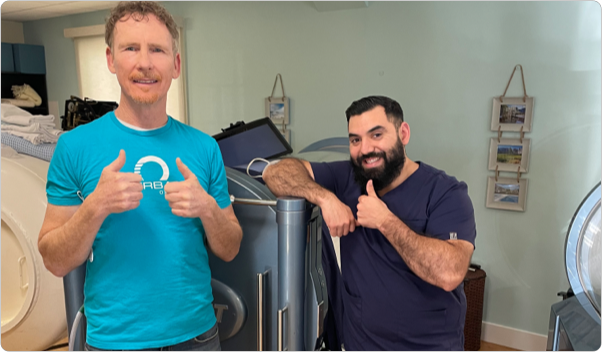Medicare Approves Hyperbarics to Treat Diabetic Wounds and Foot Ulcers

How Hyperbarics Helps
Stimulates angiogenesis
Salvages and revitalizers damaged tissue
Stimulates stem cell reproduction and mobilization
Stimulates up-regulation of growth hormones
Enhances delivery of antibiotics
Down-regulates inflammatory genes
What the Research Says
The experimentally demonstrated effects of hyperbaric oxygen therapy on:
- Improving wound tissue hypoxia
- Enhancing perfusion
- Reducing edema
- Downregulating inflammatory cytokines
- Promoting fibroblast proliferation, collagen production, and angiogenesis
make it a useful adjunct in treating problem wounds such as diabetic foot ulcers.
Is Hyperbaric Oxygen Therapy Approved?
Complications associated with diabetes are the leading cause of non-traumatic lower-extremity amputations. Hyperbaric oxygen therapy, as a medical treatment for diabetic wounds of the extremities, is approved by Medicare and the FDA, and is reimbursed by most private insurance companies.
How Does HBOT Help Diabetic Wounds and Foot Ulcers?
HBOT has been proven effective in the treatment of diabetic wounds and foot ulcers for several reasons:
- Increased Oxygenation: Diabetes can cause damage to blood vessels, leading to decreased blood flow to the extremities. This can make it difficult for the body to get the oxygen and nutrients it needs to heal wounds. HBOT increases the amount of oxygen in the body, allowing it to bypass damaged blood vessels and reach the affected areas more easily.
- Improved Tissue Regeneration: HBOT has been shown to stimulate the growth of new blood vessels and promote the production of collagen, which is essential for the healing of wounds.
- Reduced Inflammation: Diabetes can cause chronic inflammation in the body, which can slow the healing process. HBOT has been shown to reduce inflammation and improve immune function, which can help speed up the healing process.
- Antibacterial Properties: HBOT has been shown to have antibacterial properties, which can help reduce the risk of infection in diabetic wounds and foot ulcers.
What Does the Research Say?
Numerous studies have investigated the use of HBOT in the treatment of diabetic wounds and foot ulcers, with promising results. A systematic review published in the journal Diabetes Care found that HBOT was associated with a significantly higher rate of wound healing compared to standard care. In another review of 763 patients across seven studies, amputation rates decreased from 43% in patients who did not receive hyperbarics to 21% in patients who received hyperbaric oxygen therapy.
In addition, a randomized controlled trial published in the Journal of Diabetes and its Complications found that HBOT was effective in reducing the risk of amputation by over 50% in patients with diabetic foot ulcers. In another study published in Diabetes Care, patients who received HBOT had a significantly lower risk of amputation than those who received standard wound care. After one year, only 6.5% of patients who received HBOT had undergone amputation, compared to 24% of patients who received standard wound care.
In another randomized, controlled trial published in the New England Journal of Medicine, patients with diabetic foot ulcers who received HBOT had a significantly higher rate of healing than those who received standard wound care treatments alone. The study found that after 12 weeks, 56% of patients who received HBOT had complete healing of their foot ulcers, compared to only 39% of patients who received standard wound care.
Another study published in the Journal of Wound Care found that HBOT was effective in reducing the size of diabetic foot ulcers. The study included 28 patients with diabetic foot ulcers who received 40 sessions of HBOT. After 40 sessions, the average size of the foot ulcers had decreased by 92%.
Our Physician Partners Have Referred Thousands of Patients
Our physician partners have referred thousands of patients with non-healing diabetic foot wounds. Of those patients, over 75% have seen near complete healing, while over 90% have seen a significant decrease in the size of their wounds. Our medical director and nurse practitioners work closely with your care team. Have your office call our practitioners today to discuss how we might help you heal your patients.
Research Studies
Hyperbaric Treatment of Diabetic Foot Ulcers
Hyperbaric Treatment of Diabetic Foot Ulcers
Hyperbaric oxygen therapy for chronic wounds (Review)
Hyperbaric oxygen therapy for chronic wounds (Review)
Hyperbaric oxygen therapy facilitates healing of chronic foot ulcers in patients with diabetes
Hyperbaric oxygen therapy facilitates healing of chronic foot ulcers in patients with diabetes
Hyperbaric Oxygen Therapy for Diabetic Foot Wounds: Has Hope Hurdled Hype?
Hyperbaric Oxygen Therapy for Diabetic Foot Wounds: Has Hope Hurdled Hype?
Hyperbaric oxygen therapy (HBOT) has been promoted as an effective treatment for diabetic foot wounds, and the first controlled trial for this indication was reported (in Diabetes Care) over 20 years ago. Advocates have suggested that the experimentally demonstrated effects of HBOT on improving wound tissue hypoxia, enhancing perfusion, reducing edema, downregulating inflammatory cytokines, promoting fibroblast proliferation, collagen production, and angiogenesis make it a useful adjunct in clinical practice for “problem wounds,” such as diabetic foot ulcers
Patient Experiences
-

Ankur, 54
Hyperbarics was the last option for Aryan's toe before amputation. Fortunately, hyperbarics healed the wound.
Ankur is a software engineer in Silicon Valley with diabetes. Prior to coming to hyperbarics his podiatrist accidentally cut his toe while clipping his right big toe. The toe became swollen and infected, and no matter how much the podiatrist cleaned it and antibiotics did not help. The color of his toe went from red, to purple to a little dot of black on the bottom. When his physicians started to talk about amputation, his vascular surgeon prescribed hyperbarics. He was hobbling with a cane by that time and was quite scared. Hyperbarics stimulated his body to send out new growth factors, new blood vessels grew, and new nerves developed until his toe was healed. When he left us after 52 treatments he was walking without a cane and without pain.
-

Amita, 22
Gangrene on her foot would not heal. HBOT prevented amputation.
Amita was an active hiker, but because of gangrene, lost all the toes on her right foot. Unfortunately, the surgical wound from the amputation would not heal , and her doctors were planning to amputate her foot.After a series of HBOT sessions, her wound healed up. A year later when we checked in with Amita, the wound was still healed.
Physicians: Refer a Patient
You Submit Your Patient’s Information
We Get Authorizations
Patient Starts HBOT

Related articles
Research on Hyperbaric Oxygen Therapy
-
What is Hyperbaric Oxygen Therapy?
Hyperbaric oxygen therapy treats medical conditions with 100% oxygen in a pressurized hyperbaric chamber. The patient lies or sits in the chamber. The oxygen then saturates the plasma in the blood, allowing oxygen to easily flow throughout the body and reach even areas that are injured or diseased, which typically receive less oxygen. The mechanisms of hyperbaric oxygen therapy include stimulating and mobilizing stem cells, down-regulating inflammatory genes, up-regulating reproductive cells and stimulating DNA. HBOT also regrows tiny blood vessels, and stimulates the growth of new healthy cells in the brain, bones, skin, organs, and tissues. People seek hyperbaric oxygen therapy to heal physical damage in their bodies and to promoting health and anti-aging.
-
Does HBOT kill cancer cells?
Current research indicates that hyperbaric oxygen does not kill cancer cells. However, there has been a small amount of research indicating that hyperbaric oxygen might reduce the size of certain tumors. Also, there has been a study on mice using hyperbaric oxygen, along with a ketogenic diet, to reduce tumors. Hyperbaric oxygen causes many different healing modalities to kick into gear. Could its effect on strengthening the immune system inhibit the growth of cancer cells? Nobody knows. There are numerous studies conclusively showing that hyperbaric oxygen does not encourage cancer cells or tumors to grow. Some patients claim the hyperbaric oxygen makes them feel a lot more comfortable and functional after chemotherapy and also during healing. Note that some chemotherapy drugs are not to be used with hyperbaric oxygen, as the chemotherapy drugs can be enhanced and thus become toxic. A good hyperbaric oxygen facility (such as Bay Area Hyperbarics) will always call the chemotherapy manufacturer to ensure that hyperbaric oxygen therapy will be helpful and not damaging to the patient.
-
IWhat is the CPT code for HBOT?
The CPT code for HBOT is G0277.
-
Does Medicare cover HBOT?
Medicare covers Hyperbaric Oxygen Therapy for approved conditions, and many insurance companies also cover approved conditions. If your condition is not approved by your insurance, we can discuss our special rates. Give us a call at (408) 356–7438. We are happy to discuss your options with you.
-
Can HBOT help Neuropathy?
Hyperbaric treatments help heal neuropathy by regrowing small blood vessels and nerves that have died from disease, injuries from radiation and aging. Patients often experience numbness and or pain when they start treatment. Hyperbaric treatments most often bring back sensation and make, for example, walking easier and more enjoyable.
-
Why would a physician consider HBOT?
A physician would consider using hyperbaric chamber therapy under a variety of situations. Physicians most typically refer patients to hyperbarics when the patient is not healing with traditional medical interventions and hyperbaric chamber therapy is approved by Medicare for this condition. Some patients experience significant unresolved pain and unremitting disease states that the mechanisms of hyperbaric oxygen therapy in a hyperbaric chamber are known to affect, such as the down regulation of inflamatory genes. For an example, some patients have experienced severe, unremitting hives with itching, which did not improve with any specialists interventions. Some physicians will consider hyperbaric chamber therapy if the patient has no other good avenues for improving their failing health, and they know the hyperbaric chamber therapy is safe and will not harm the patient.
-
What is Hypebaric Oxygen Therapy?
Hyperbaric Oxygen Therapy (HBOT) Hyperbaric Oxygen Therapy (HB0T) is a medical treatment where you inhale 100% oxygen in a chamber with increased atmospheric pressure. HBOT injects 400x the oxygen into your tissues and bones and mobilizes stem cells. It regrows healthy tissues in the brain, blood vessels, skin and bones. It also reduces pain and swelling, and speeds recovery. It is simple, effective and painless.
Have more Questions?




